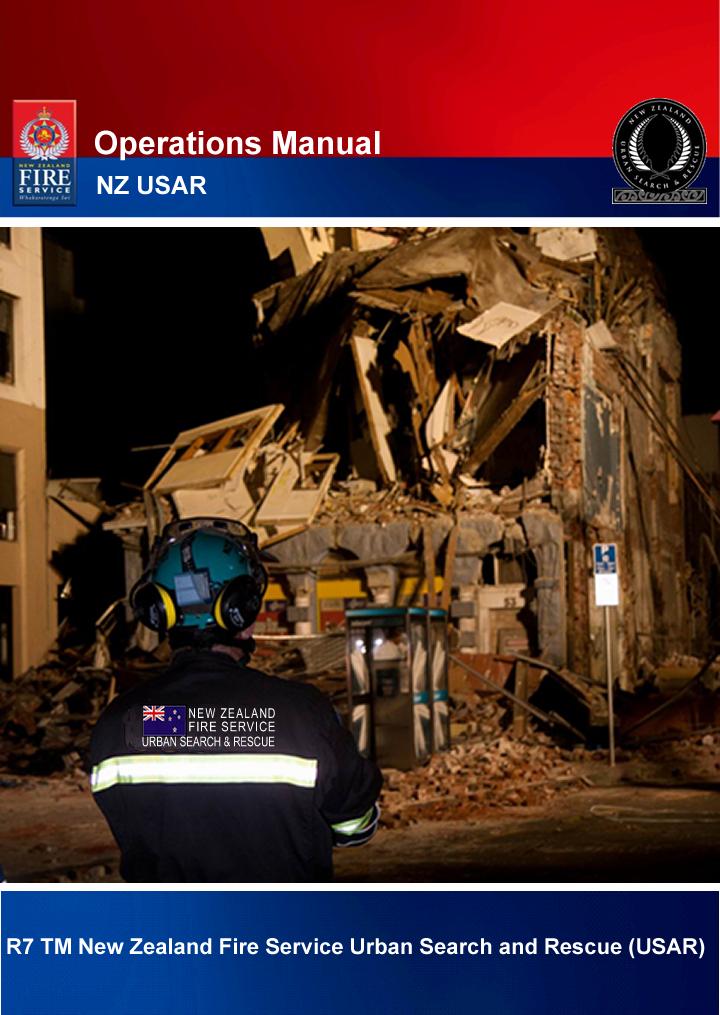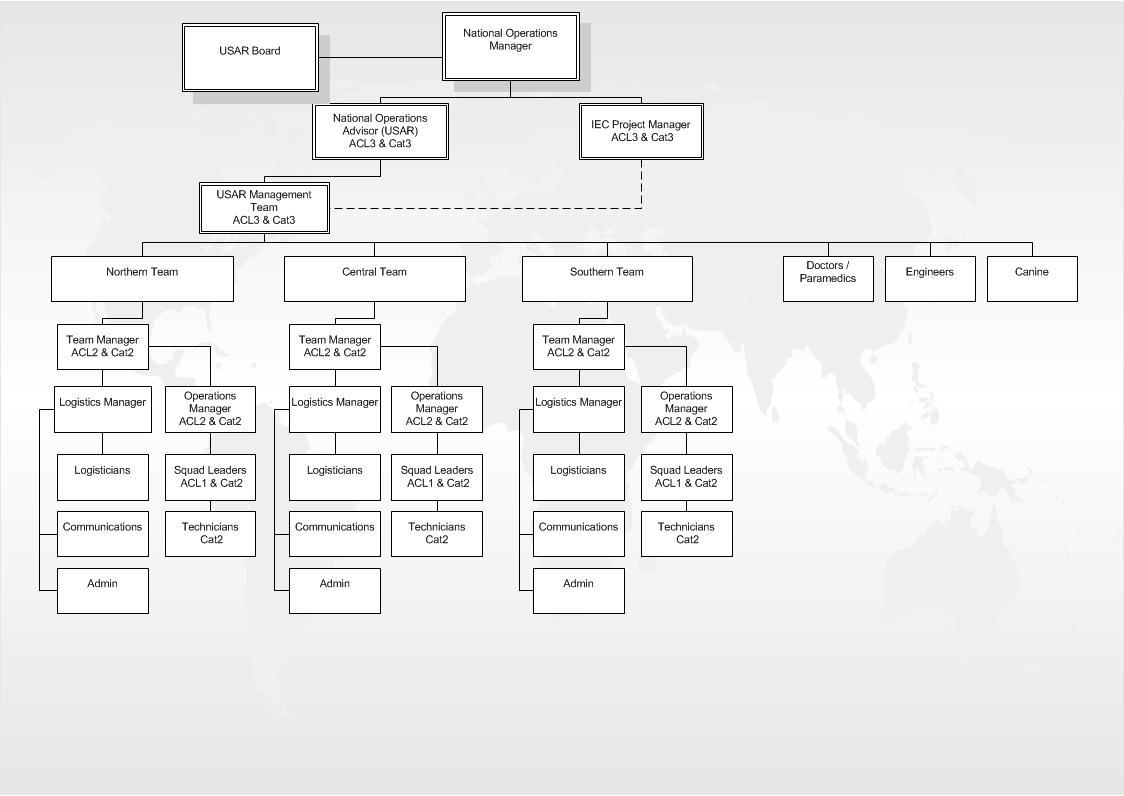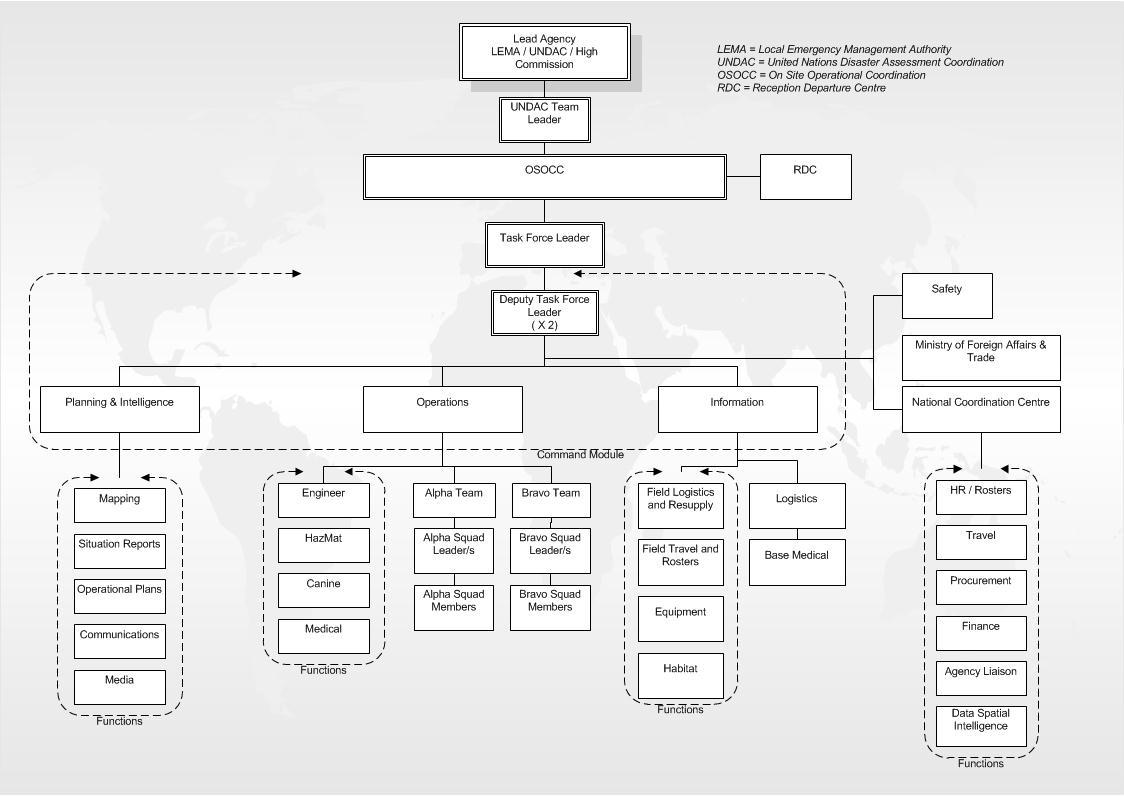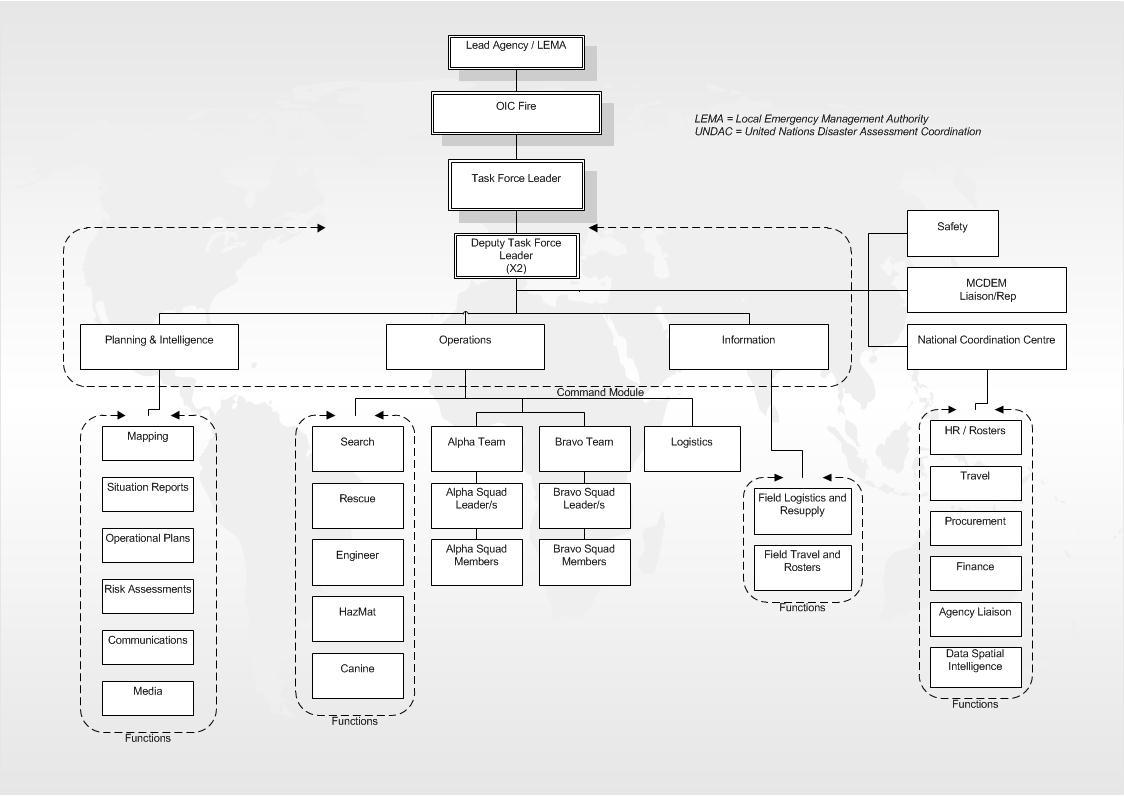
1982
Act
Information
Official
the
under
Released
link to page 4 link to page 5 link to page 6 link to page 7 link to page 8 link to page 8 link to page 9 link to page 9 link to page 11 link to page 11 link to page 12 link to page 13 link to page 14 link to page 15 link to page 16 link to page 16 link to page 17 link to page 17 link to page 18 link to page 19 link to page 20 link to page 21 link to page 22 link to page 23 link to page 24 link to page 25 link to page 25 link to page 26 link to page 27 link to page 27 link to page 28 link to page 29 link to page 30 link to page 30 link to page 31 link to page 31 link to page 32 link to page 33 link to page 34 link to page 35
MANUAL - USAR Operations
Contents
Related documents ............................................................................................................. 4
Introduction ......................................................................................................................... 5
USAR capability and activation ...................................................................................... 6
International guidelines .................................................................................................. 7
NZ USAR Board, AFAC and government roles ................................................................. 8
NZ USAR Board............................................................................................................. 8
AFAC USAR & Technical Rescue Group ....................................................................... 9
New Zealand Government agencies .............................................................................. 9
USAR training and exercising .......................................................................................... 11
Training ........................................................................................................................ 11
Category 1 Awareness (Cat-1A) .................................................................................. 12
Category 1 Response (Cat-1R) .................................................................................... 13
Category 2 Technician (Cat-2) ..................................................................................... 14
Category 3 Manager (Cat-3) ........................................................................................ 15
Exercises and skil s maintenance ................................................................................ 16
Training and skil s maintenance responsibilities ........................................................... 16
Organisation structure ..................................................................................................... 17
NZ USAR organisation structure .................................................................................. 17
USAR international deployment structure .................................................................... 18
USAR national deployment structure ........................................................................... 19
71-person international Task Force .............................................................................. 20
USAR domestic deployment ........................................................................................ 21
USAR Roles ....................................................................................................................... 22
National Operations Advisor USAR .............................................................................. 23
USAR Management Team ........................................................................................... 24
Task Force Leader ....................................................................................................... 25
Deputy Task Force Leader ........................................................................................... 25
Team Manager ............................................................................................................ 26
Operations Officer ........................................................................................................ 27
Planning / Intelligence Of icer....................................................................................... 27
Information Officer ....................................................................................................... 28
under the Official Information Act 1982
Logistics Officer ........................................................................................................... 29
Hazmat / Safety .......................................................................................................... 30
Squad Leader .............................................................................................................. 30
Technician ................................................................................................................... 31
Paramedics .................................................................................................................. 31
Doctors ........................................................................................................................ 32
Communications / ICT ................................................................................................. 33
Engineers .................................................................................................................... 34
Released
Canine ......................................................................................................................... 35
NZFS National Operations
R7 TM USAR Operations Manual.docx
Page 2 of 54
link to page 36 link to page 36 link to page 37 link to page 38 link to page 39 link to page 40 link to page 41 link to page 42 link to page 43 link to page 43 link to page 44 link to page 47 link to page 48 link to page 48 link to page 49 link to page 49 link to page 50 link to page 51 link to page 53
MANUAL - USAR Operations
USAR activity phases ....................................................................................................... 36
Planning ....................................................................................................................... 36
Activation and notifications ........................................................................................... 37
In transit ....................................................................................................................... 38
Operations ................................................................................................................... 39
Reassignment / demobilisation .................................................................................... 40
Return to home base ................................................................................................... 41
1982
Checklist .......................................................................................................................... 42
USAR operations within NZ .............................................................................................. 43
Domestic USAR deployment ........................................................................................
Act 43
Receiving international USAR resources ..................................................................... 44
USAR medical capability .................................................................................................. 47
USAR equipment ............................................................................................................... 48
USAR Task Force cache .............................................................................................. 48
During deployments ..................................................................................................... 49
Personal Protective Equipment (PPE) .......................................................................... 49
Training safety ............................................................................................................. 50
Public information and media management ................................................................... 51
Information
Glossary ............................................................................................................................ 53
Official
the
under
Released
NZFS National Operations
R7 TM USAR Operations Manual.docx
Page 3 of 54
MANUAL - USAR Operations
Related documents
The following documents provide information relevant to this procedure:
R7 POP USAR policy
R7 GD NZFS guide to USAR
R7 SCa Schedule of USAR conditions
1982
R7 SCb Schedule of USAR assembly points
R7 SCc Schedule of USAR medical capability
R7 SCd USAR standards of conduct and code of Ethics
R7 SCe USAR safety and wellbeing
Act
R7 SOP International or domestic USAR activation procedure
R7 TM USAR Operations manual.
Record of amendments
Date
Brief description of amendment
15 Jan 2014
Section titles – Flow chart corrections – Terminology corrections
25 Feb 2014
Reviewed by workshop at NHQ
July 2014
Information on safety and wel being, code of conduct and medical staff tasks relocated into
separate schedule documents.
Information
Jan 2015
Updated Org charts, Role descriptions, removed building marking
Official
the
under
Released
NZFS National Operations
R7 TM USAR Operations Manual.docx
Page 4 of 54
MANUAL - USAR Operations
Introduction
Purpose of this
This manual provides the operational protocols and processes for
manual
management of an Urban Search and Rescue (USAR) Task Force
response to an emergency event within New Zealand.
Background
International structural collapse disasters, such as the earthquakes in
1982
Turkey and Taiwan (1999), India (2001, Pakistan (2005), Haiti (2010) and
Christchurch (2010 & 2011) have highlighted the need for a national
coordinated approach in training personnel to perform specialist rescue
tasks beyond the capabilities of local resources.
Act
A heightened risk of major structural collapse exists - due to increasing
urbanisation, and a growing range of hazards, both natural (landslides,
earthquakes, severe storms) and technological (heavy transport
accidents in urban areas).
Events in recent years have led to the international development of
specialised USAR teams in a number of countries, including New
Zealand.
NZ USAR
The National Civil Defence Emergency Management Plan (2005) Order
recognises that the New Zealand Fire Service (NZFS) has responsibility
Information
for the development and management of NZ‟s USAR capabilities.
New Zealand has adopted a Federal Emergency Management Agency
(FEMA) approach in developing a USAR capability, based upon the
INSARAG methodology. Within New Zealand, USAR is defined as a
specialised technical rescue capability for the location and rescue of
entrapped people following a structural collapse.
Official
The arrangements surrounding USAR exist to facilitate:
an effective national and international response to structural collapse
incidents the
the acceptance of USAR resources into New Zealand.
Related
NZFS documents that relate to NZ USAR include:
documents
NZFS USAR Policy (R7 POP)
Schedule of USAR conditions (R7 SCa)
under
Schedule of USAR assembly points (R7 SCb)
NZFS Guide to USAR (R7 GD)
Working at heights and line rescue (R3 POP)
External documents that relate to NZ USAR include:
Guidance for Establishing and Operating NZ Response Teams (NZ-
RTs) - Director’s Guidelines for the CDEM Sector, April 2012
INSARAG Guidelines and Methodology - April 2012
OSOCC Guidelines – 2nd edition 2009
Released
NZFS National Operations
R7 TM USAR Operations Manual.docx
Page 5 of 54
MANUAL - USAR Operations
USAR capability and activation
Capability
A USAR response consists of highly-trained, multi-agency specialists,
responsible for their own safety. USAR operates within a defined
structure as a NZFS specialised resource, working under NZFS and
Emergency Management arrangements.
USAR resources may be used in:
1982
small localised domestic events
domestic events in support of a wider Civil Defence Emergency
response
Act
in support of a formal international request for assistance (resulting
from either a bilateral agreement or the United Nations).
An effective USAR response requires personnel from different disciplines
to train and work together for maximum efficiency, and an integrated
response system. This involves highly specialised equipment, ef ective
communications, logistics and an established command and control
system.
There needs to be a very thorough understanding within the emergency
management community of the specialist and technical skil s developed
by USAR trained personnel. USAR teams must be able to operate in a
Information
manner that allows them to undertake their own risk assessment and
safety management.
Self-sufficiency Due to the complexity of disasters, and the possibility of limited resources
available from the affected area, a USAR response should be self-
sufficient for a minimum of 72 hours from the time of commencing
operations in the incident area, with a pre-planned re-supply capability
Official
allowing for self-sufficiency for 14 operational days.
Activation
Any member of the Civil Defence and Emergency Management (CDEM)
community can initiate incident notifications through the NZFS
the
Communications Centres (ComCen), as outlined in CDEM readiness
arrangements.
Police, Fire and Ambulance services may also make a request for USAR
assistance during operations if the local rescue resource is overwhelmed
by the nature of the incident. This request is made through the ComCen.
under
When an event occurs and a USAR “trigger” is reached, the ComCen wil
notify the on-call USAR Management Team (UMT) member to advise
them of the incident.
The UMT wil progress a notification from "notification" to "response"
phase by obtaining authority from the NZFS National Commander.
Released
NZFS National Operations
R7 TM USAR Operations Manual.docx
Page 6 of 54
MANUAL - USAR Operations
International guidelines
Introduction
Experience has shown that the magnitude of an incident can quickly
overwhelm local USAR resources, leading to the need for coordinated
national and/or international assistance.
This manual follows recommendations from the International Search and
Rescue Advisory Group (INSARAG) Response Guidelines, published by
1982
the United Nations Office for Co-ordination of Humanitarian Affairs
(UN OCHA).
Act
INSARAG
INSARAG is a global network of more than 80 countries and disaster
response organisations that provides minimum standards and best
practice guidelines for search and rescue, for both earthquake-prone
countries and organisations.
New Zealand helps make up this community of member countries, as
part of the Asia/Pacific Regional group.
UN OCHA
Within the UN OCHA, the United Nations Disaster Assessment and
Coordination (UNDAC) system means that teams are on permanent
standby in their resident country.
These teams may be called upon internationally in times of disaster,
Information
where their role is to provide information concerning the disaster situation
and the needs of the victims to the international community through
OCHA.
Official
the
under
Released
NZFS National Operations
R7 TM USAR Operations Manual.docx
Page 7 of 54
MANUAL - USAR Operations
NZ USAR Board, AFAC and government roles
NZ USAR Board
Role
The role of the NZ USAR Board is to oversee the strategic direction,
development and management of New Zealand‟s urban search &
rescue capabilities.
1982
Objectives
The objectives of the NZ USAR Board are to:
Ensure the development of policy and frameworks within which the
Act
objectives of the NZ USAR capability can be met.
Establish the linkages between all of the agencies that contribute to
the NZ USAR capability.
Ensure that international and national best practice standards are
implemented for USAR qualifications and training.
Ensure that the approved USAR Teams, Registered Response
Teams and other specialist skil assets are appropriately resourced
and capable of being deployed; the Commit ee, as part of its
responsibilities, wil work with the NZFS request that sufficient
funding is available from government for that purpose.
Ensure that appropriate arrangements are in place for international
Information
teams coming into New Zealand to give assistance, and for New
Zealand teams who may provide assistance overseas.
Establish and maintain a national exercise programme to test and
evaluate USAR capability.
Monitor and report on the integrated USAR capability to all
stakeholders.
Establish and maintain all the components of a comprehensive,
Official
multi-agency USAR capability.
Ensure operational readiness of all elements of the USAR
capability. the
Ensure integration of the USAR capability within CDEM and NZFS
operational arrangements.
Reporting
The NZ USAR Board reports through the Ministry of Civil Defence &
Emergency Management (MCDEM) to the Minister Civil Defence -
annually, or as required.
under
Structure
The Board is currently chaired by the New Zealand Fire Service, and
includes representatives from:
New Zealand Fire Service
Ministry of Civil Defence & Emergency Management
New Zealand Police
Local Government.
New Zealand Defence
Released
Reporting
Diagrams of the reporting structures for different types of USAR
structure
deployment are located in
R7 GD NZFS Guide to USAR.
NZFS National Operations
R7 TM USAR Operations Manual.docx
Page 8 of 54
MANUAL - USAR Operations
AFAC USAR & Technical Rescue Group
Role
The Australasian Fire and Emergency Service Authorities Council
(AFAC) USAR & Technical Rescue Group (AFAC USAR TRG) was
established to assist AFAC member agencies to implement an effective,
structured, interoperable, multi-agency capability for preparation,
response and recovery from local, interstate and international structural
1982
collapse emergencies, and from disasters requiring a USAR response.
Objectives
The objectives of the AFAC USAR TRG are to:
Develop and implement the AFAC USAR Strategic Plan, which
Act
promotes Fire Service capability to manage emergencies requiring a
USAR response.
Provide effective Fire Service inputs to the development of the
National USAR Plan and the activities of the multi-agency National
USAR Steering Commit ee.
Promote development of a sustainable, integrated, national, multi-
agency response capability.
Promote best practice in USAR management within Fire Services.
Provide national overview and recommendations on Fire Service
USAR capabilities to the Urban Operations Sub-Group and AFAC
Council.
Information
Reporting
The AFAC USAR TRG takes strategic direction from and reports to the
AFAC Urban Operations Sub-Group.
The NZFS National Operations Advisor (USAR) sits on the AFAC
Technical Rescue Working Group.
Official
New Zealand Government agencies
DPMC
The Department of the Prime Minister and Cabinet (DPMC) is
the
responsible for approving international requests for USAR assistance
(incoming and outgoing).
MCDEM
The Ministry of Civil Defence and Emergency Management (MCDEM),
as part of the Department of Internal Affairs (DIA), is the New Zealand
Government agency responsible for the coordination of New Zealand‟s
under
domestic emergency management arrangements.
This is facilitated through the National Crisis Management Centre
(NCMC) and the Civil Defence and Emergency Management (CDEM)
structure. MCDEM wil also address requests for, and offers of,
overseas assistance through the government crisis management
arrangements of the Officials Domestic and External Security
Coordination (ODESC).
During an emergency situation involving a national USAR response, the
Released USAR Management Team (UMT) wil ensure an officer is assigned to
the NCMC.
NZFS National Operations
R7 TM USAR Operations Manual.docx
Page 9 of 54
MANUAL - USAR Operations
New Zealand
The New Zealand Customs Service is the government agency with the
Customs Service job of protecting New Zealand from potential risks from international
trade and travel, while facilitating the legitimate movement of people
and goods across our borders.
Ministry for
The Ministry for Primary Industries (MPI) plays a major role in protecting
Primary
New Zealand‟s environment, by maintaining and enhancing bio-1982
Industries (MPI)
security, particularly at the border.
Immigration
The Immigration Service is responsible for the correct entry procedures
Act
Service
of persons entering New Zealand. The NZ Customs Service does the
processing at our borders on their behalf.
ODESC
Officials Committee for Domestic and External Security Coordination.
Ministry of
The Ministry of Foreign Affairs and Trade (MFAT) is responsible for:
Foreign Affairs
managing the whole-of-government response to an incident
and Trade
overseas that affects New Zealand Citizens
(MFAT)
managing the overall relationship with the requesting country
advising DPMC and MCDEM on issues relating to authorisation for
the deployment of New Zealand emergency response teams.
Information
MFAT's consular officers, either posted overseas or despatched from
New Zealand to assist New Zealanders in affected areas, work together
with emergency services teams to:
help locate missing New Zealanders
organise access to medical facilities
facilitate the return of New Zealanders to New Zealand
organise medical evacuations and the repatriation of New Zealand
Official
remains.
MFAT also manages consular contingency plans for countries where
New Zealand has no official representation. The plans look at possible
the
triggers for crises that might affect New Zealanders in those countries,
such as natural disasters, and provides guidance for initial responses.
under
Released
NZFS National Operations
R7 TM USAR Operations Manual.docx
Page 10 of 54
MANUAL - USAR Operations
USAR training and exercising
Introduction
To ensure New Zealand‟s USAR capability is maintained at a high state
of readiness, it is crucial that USAR personnel develop and maintain their
skil s to the highest possible levels.
To this end, a programme of training and regular exercises is in place.
1982
Training
USAR
USAR is a system that amalgamates the specific requirements of:
Act
requirements
confined space rescue
vertical rope rescue
trench rescue
building collapse rescue
tunnel ing
atmospheric monitoring
concrete breaching
electronic/optical search
long-duration operations
field living skil s.
Information
Technological
In recent years USAR training has advanced to keep pace with
developments
technological developments, particularly relating to reinforced, pre- and
post-stressed concrete, and tilt slab construction.
These developments have necessitated training in, and use of electronic
listening devices, fibre optics, mini cameras, and reinforced concrete
penetration tools, as well as the need for atmospheric monitoring prior to
Official
entry, and decontamination procedures on exit.
Training
USAR-specific training courses are as follows:
the
courses
Category 1 Awareness (Cat-1A)
Category 1 Response (Cat-1R)
Category 2 Technician (Cat-2)
Category 3 Manager (Cat-3)
Of these, the following are Emergency Management EMQUAL-supported
under
training packages:
Cat-1A
Cat-1R
Cat-2
Each training course is described in more detail on the following pages.
Released
NZFS National Operations
R7 TM USAR Operations Manual.docx
Page 11 of 54
MANUAL - USAR Operations
Category 1 Awareness (Cat-1A)
Purpose
The purpose of USAR awareness training is to make trainees aware of
national and international USAR systems that they may encounter at a
structural collapse incident.
This is the minimum training level for all emergency service personnel.
1982
Content
The online-training covers:
NZ USAR response system
Integrating CIMS with USAR
Act
Personal protective equipment (PPE)
Structural marking systems
Search marking systems
Warning signals
Collapse patterns
Initial action strategies.
Prerequisites
None.
Target groups
Fire (all personnel)
Ambulance (all personnel)
Information
Police (all personnel)
Civil Defence (all sections)
Structural engineers
Support agencies
Other government organisations
Communications Centre staff
Neighbourhood Support Groups
Official
Security companies
Building wardens
Workplace Emergency Response Teams
the
General public.
Trainer
This is an online learning course. It can be found on the Ministry of Civil
requirements
Defence and Emergency Management website.
Certification
USAR Certificate (Introduction).
under
Released
NZFS National Operations
R7 TM USAR Operations Manual.docx
Page 12 of 54
MANUAL - USAR Operations
Category 1 Response (Cat-1R)
Purpose
The purpose of this training is to establish:
a first response and Task Force logistics capability, with self-sufficient
skil s, to conduct First Aid, surface and low height rescue operations
first response capability within key organisations.
This is the minimum training required for all Task Force logistics 1982
personnel (communications, logistics, high angle, canine search etc.).
Content
The training covers:
Act
First Aid/CPR (NZQA 6400, 6401, 6402)
Introduction to CIMS (NZQA 17279)
General Rescue (NZQA 7318/10618)
Competency Assessment (NZQA 18516)
Hazards
Safety in rescue
Safe working practices
Reconnaissance
Anchors
Basic rope work
Casualty handling
Information
Ladders
Low height rescues
Improvised rescues
Confined space operations
Interview
Rubble crawl
Official
Line and hail search
Stretcher carry
Response exercises
the
Building construction
Occupancy collapse patterns
Secondary collapse indicators.
Duration
One week.
under
Prerequisites
USAR Cat1A - Awareness (NZQA 18516).
Released
NZFS National Operations
R7 TM USAR Operations Manual.docx
Page 13 of 54
MANUAL - USAR Operations
Target groups
NZFS (all career staff)
Ambulance (as required)
Civil Defence (Rescue section)
Structural engineers (specialist)
Community rescue teams
Other rescue organisations (SAR etc.)
Building wardens
1982
Workplace Emergency Response Teams
Task Force technicians
USAR canine search specialists
Act
Local Rescue Teams (including Red Cross).
Trainer
First Aid NZ Resuscitation Council - Level 2 Instructor
requirements
NZQA Accredited Provider
CIMS LG/FRS ITO Assessor
General Rescue
USAR General Rescue Trainer
USAR Orange card (NZQA 18516).
Certification
USAR Orange card (Responder) Information
FRSITO USAR Responder Certificate.
Category 2 Technician (Cat-2)
Purpose
The purpose of this training is to provide internationally compatible
medium/heavy rescue capability for specialist and subterraneous search
and rescue operations. Official
This is the minimum training required for all Task Force technicians.
Content
The training covers:
the
Health and safety
Physical conditioning/challenge
Tool familiarisation
Structural engineering
Lifting and cribbing
under
Burning, cutting, breaking, breaching
Shoring
Patient care
Technical search
Disaster Victim Identification (DVI)
Deployment procedures
72 hour exercise.
Duration
Three weeks (initial).
Released
NZFS National Operations
R7 TM USAR Operations Manual.docx
Page 14 of 54
MANUAL - USAR Operations
Prerequisites
USAR Responder
New Zealand Fire Service Member
New Zealand registered Advanced Paramedic
Trainer
NZFS PDU Registered Tutor (USAR Cat-2).
Requirements
Note: This course is exclusively accredited to the NZFS Professional
1982
Development Unit, to ensure quality standards are met.
Certification
NZQA/NZFS PDU Course Certificate (USAR Technician)
USAR Orange Card (Technician)
Act
Category 3 Manager (Cat-3)
Purpose
The purpose of this training is to provide Task Force Managers and
leaders with the skil s to:
establish pre-deployment procedures
manage Task Force training
provide sound operational advice to the Incident Controller
enforce USAR policies and procedures
manage welfare and occupational safety and health requirements
Information
Content
The training covers:
Leadership, command and control
Co-ordinated incident management systems (CIMS)
Task Force deployment / demobilisation management
Structural collapse incident management
Official
INSARAG procedures/guidelines
Media management
OSOCC / RDC procedures.
the
Duration
Residential and distance learning.
Prerequisites
NZFS Officer
USAR Cat-1R.
under
Target group
USAR Management Team (Task Force Leader/Deputy).
Certification
USAR Orange Card (Manager).
Released
NZFS National Operations
R7 TM USAR Operations Manual.docx
Page 15 of 54
MANUAL - USAR Operations
Exercises and skills maintenance
Exercises
The USAR task force are required to complete a 24-hour exercise every
year (refer
USAR policy - R7 POP).
Skills
Skil s maintenance and enhancement requires frequent and regular:
maintenance
training and practice across the range of USAR skil s
and
1982
enhancement
assessment and recording of all training and development of team
members.
Teams wil be required to resource all such training, and to utilise skil s
Act
within teams to develop training modules and exercises aimed at
maintaining and enhancing capability. This wil be carried out in
consultation with the Training work-stream.
Training and skills maintenance responsibilities
NZFS
The NZFS is responsible for the delivery, programming and resourcing of
Cat1-R, CAT-2 and CAT-3 training and development for NZFS personnel.
USAR
The
UMT is responsible for:
Management
Information
Demonstrating Task Force governance.
Team (UMT)
Providing incident management skil s.
Maintaining an “enabling environment”.
Leading functional work-streams
Operating within financial guidelines.
Endorsing national policy and procedures.
Promoting USAR visibility local y and nationally.
Official
Contributing to national exercises and training that:
- promotes interoperability and integration of teams
- simulates CDEM operational environments
the
- simulates “operational” conditions
- encourages interaction with Regional and/or national and
international CDEM arrangements.
Team
Team Managers are responsible for:
Managers
The “business as usual” activities of the team.
under
A management position during deployment.
Skil s maintenance and regular skil -based training for their team.
Developing an annual training program in consultation with the
training work-stream to:
- ensure compliance with training standards
- al ow identification of regional and national training
- record all team training in SMS and OSM.
Released
NZFS National Operations
R7 TM USAR Operations Manual.docx
Page 16 of 54
 MANUAL - USAR Operations
MANUAL - USAR Operations
1982
Organisation structure
Act
NZ USAR organisation structure
Information
Official
the
under
NZFS National Operations
R7 TM USAR Operations Manual.docx
Page 17 of 54
Released
 MANUAL - USAR Operations
MANUAL - USAR Operations
1982
USAR international deployment structure
Act
Information
Official
the
under
NZFS National Operations
R7 TM USAR Operations Manual.docx
Page 18 of 54
Released
 MANUAL - USAR Operations
MANUAL - USAR Operations
1982
USAR national deployment structure
Act
Information
Official
the
under
NZFS National Operations
R7 TM USAR Operations Manual.docx
Page 19 of 54
Released
MANUAL - USAR Operations
71-person international Task Force
Role
Number
Authorised
Complement
Command
Level (ACL)
Task Force Leader
1
ACL3
Deputy Task Force Leader
2
ACL3
1982
Govt Liaison
2
Planning/Intelligence
2
ACL2
Act
Operations Officers
2
ACL2
Information Officers
2
Command / IT
2
Doctors
2
Can be supported by Advanced
Paramedic
Engineers
2
Canine Team
4
Logistics Manager
2
Information
8 x Logistics Support
Logistics Team
14
4 x Technician Support
2 x TFS Coms Operators
Communications / ICT
2
2 x TFS Coms Operators
Official
Hazmat / Safety
2
1 x Cat 2 Rescue Squad Leader
the
Alpha 1 Rescue Team
8
ACL1
6 x Cat 2 Rescuers
1 x Cat 2 Paramedic
1 x Cat 2 Rescue Squad Leader
Alpha 2 Rescue Team
ACL1
6 x Cat 2 Rescuers
under 8
1 x Cat 2 Paramedic
1 x Cat 2 Rescue Squad Leader
Bravo 1 Rescue Team
ACL1
6 x Cat 2 Rescuers
8
1 x Cat 2 Paramedic
1 x Cat 2 Rescue Squad Leader
Bravo 2 Rescue Team
8
ACL1
6 x Cat 2 Rescuers
Released
1 x Cat 2 Paramedic
71
NZFS National Operations R7 TM USAR Operations Manual.docx
Page 20 of 54
MANUAL - USAR Operations
USAR domestic deployment
Role
Number
Authorised
Complement
Command
Level (ACL)
Task Force Leader
1
ACL3
Deputy Task Force Leader
2
ACL3
1982
Govt Liaison
2
Planning/Intelligence
2
ACL2
Act
Operations Officers
2
ACL2
Information Officers
2
Command / IT
2
Doctors
2
Can be supported by Advanced
Paramedic
Engineers
2
Canine Team
4
Logistics Manager
2
Information
8 x Logistics Support
Logistics Team
14
4 x Technician Support
2 x TFS Coms Operators
Communications / ICT
2
2 x TFS Coms Operators
Official
Hazmat / Safety
2
1 x Cat 2 Rescue Squad Leader
the
Alpha 1 Rescue Team
8
ACL1
6 x Cat 2 Rescuers
1 x Cat 2 Paramedic
1 x Cat 2 Rescue Squad Leader
Alpha 2 Rescue Team
ACL1
6 x Cat 2 Rescuers
under 8
1 x Cat 2 Paramedic
1 x Cat 2 Rescue Squad Leader
Bravo 1 Rescue Team
ACL1
6 x Cat 2 Rescuers
8
1 x Cat 2 Paramedic
1 x Cat 2 Rescue Squad Leader
Bravo 2 Rescue Team
8
ACL1
6 x Cat 2 Rescuers
Released
1 x Cat 2 Paramedic
71
NZFS National Operations R7 TM USAR Operations Manual.docx
Page 21 of 54
MANUAL - USAR Operations
USAR Roles
Roles
USAR roles include:
National Operations Advisor (USAR)
USAR Management Team (UMT)
Task Force Leader and Deputy Task Force leader
Team Manager
1982
Operations Officers
Planning/Intelligence Officers
Information Officer
Act
Logistics Officer
Hazmat/Safety
Squad Leaders
Technicians
Paramedics
Doctor
Communications
Engineers
Canine
Each of these is described in more detail on the following pages.
Information
Official
the
under
Released
NZFS National Operations R7 TM USAR Operations Manual.docx
Page 22 of 54
MANUAL - USAR Operations
National Operations Advisor USAR
Overview
The National Operations Advisor USAR is a permanent position to lead
USAR in a business as usual capacity. The National Advisor will also
support the USAR operations as determined by the NZFS National
Commander.
Number
One
1982
Training
NZFS Area Commander.
CAT-1R and CAT-3 (ACL3).
Act
Reports to
OIC Fire/Incident Controller/ USAR Commander (during operations).
National Operations Manager.
Identification
White Helmet.
Key
The strategic and operational coordination of New Zealand‟s USAR
responsibilities
capabilities, including:
- management of international assets (where deployed)
- on-call response requirements.
Manage the development and deployment of NZ‟s USAR capability
including the management of staff (internal and external) and budgets
Information
in line with NZFS policies
Developing policy and procedures according to assigned subject
areas
Providing related advice and support to Region and Area managers,
and other functional managers and staf
Ensuring the advice and support provided to managers is consistent
across NZFS by working collaboratively with other National Advisors
Official
(Operations).
Key
Working effectively with other members of the wider National
the
responsibilities
Operations team to ensure that the work of the team is integrated,
(continued)
coordinated, and meets the needs of NZFS managers
Accessing expertise from specialists within the wider National
Operations team to ensure that the advice, support and solutions
provided to managers are considered best practice and consistent
with organisational policy and direction
under
Contributing to National incident management, such as the operation
of the National Crisis Management Centre, National Coordination
Centre and National Commanders Group
Released
NZFS National Operations R7 TM USAR Operations Manual.docx
Page 23 of 54
MANUAL - USAR Operations
USAR Management Team
Overview
The USAR Management Team (UMT) provides the governance and
strategic direction for New Zealand USAR.
Training
Al members of the UMT are to be CAT-1R and CAT-3 trained and
qualified.
1982
Reports to
National Operations Manager.
Identification
White helmet with the words appropriate to the operational role they are
fulfil ing.
Act
Manage the USAR incident notification & deployment approval
Key
responsibilities
system
Deploy with advanced Team/Task Force if required (depends on
nature of incident).
Liaise with Local Emergency Management Authorities (LEMA).
Provide a link between the Task Force Leader, LEMA and OSOCC.
Remain with UN OSOCC if required.
Manage assistance requests from Task Force Leaders.
Ensure staff welfare system activated.
Information
Hold financial delegation authority.
Support team managers with team management, skil s maintenance
training.
Monitor USAR Team finance.
Provide reports and information on USAR Task Force capability and
status to CDEM Groups, local emergency management services, and
to other organisations as required.
Official
Update NZFS National Operations functional Group on Task Force
capability.
Manage welfare and critical incident support for teams.
the
under
Released
NZFS National Operations R7 TM USAR Operations Manual.docx
Page 24 of 54
MANUAL - USAR Operations
Task Force Leader
Overview
Task Force Leaders work a rotating 12-hour shift, with an overlap in shifts
whenever there are two assigned watches, so as to maintain contact with
the entire Task Force during USAR operations.
Number
One
1982
Training
CAT-1R and CAT-3 (ACL3).
Reports to
Incident Controller / OIC Fire / LEMA.
Act
Identification
White helmet with the words “Task Force Leader”.
Key
Overall command and control of the Task Force.
responsibilities Managing the deployment and withdrawal of the Task Force.
Evaluating intelligence to develop and administer action plans for
Task Force operations (in conjunction with Operations Officer and
Incident Controller).
Managing staff welfare.
Liaison between Task Force and Incident Controller.
Liaison with USAR Management Team.
Information
Production and dissemination of SitReps.
Media liaison.
Conducting briefings and debriefings.
Task Force safety.
Deputy Task Force Leader
Official
Overview
Deputy Task Force Leaders work a rotating 12-hour shift, with an overlap
in shifts whenever there are two assigned watches, so as to maintain
the
contact with the entire Task Force during USAR operations.
The duties, responsibilities etc are the same as the Task Force Leader
Number
Two
under
Released
NZFS National Operations R7 TM USAR Operations Manual.docx
Page 25 of 54
MANUAL - USAR Operations
Team Manager
Overview
Team Managers are in place during “business as usual”.
Number
One per team
Training
CAT-2 (ACL 2)
1982
Reports to
USAR Management Team.
Identification
n/a
Key
Managing USAR base and equipment cache.
Act
responsibilities Ensuring Team and equipment are maintained ready to respond.
Ensuring the cache is reinstated on return from deployment.
Managing the annual budget (in conjunction with UMT).
Preparing the annual skil s maintenance training programme, linked
to the national training and exercise programme.
Managing staff issues.
Liaising with team members and managers.
Conducting Team meetings.
Liaising with UMT and other teams.
Managing health and safety compliance.
Monitoring welfare of team members.
Information
Official
the
under
Released
NZFS National Operations R7 TM USAR Operations Manual.docx
Page 26 of 54
MANUAL - USAR Operations
Operations Officer
Overview
This is an operations management role. Operations Officers work the
same hours as their shift.
Number
Two per Task Force - one attached to each shifts.
1982
Training
CAT-2 (ACL 2)
Reports to
Task Force Leader/Deputy
Act
Identification
White helmet with the words “Operations Officer”.
Key
Liaison between:
responsibilities
- Task Force Leader, Deputy TFL and Squad leaders
- the shift and external services providers in attendance.
Liaison with Logistics, Canine, Medics, Hazmat and Engineers
Officers.
Monitoring squad safety, health and welfare.
Conducting:
- briefings for the incoming Operations Officer and squads
Information
- debriefings for staff going off duty.
Implementation of all operational tasks at incident site.
Assisting with the preparation of Situation reports.
Stepping up to Task Force Leader role if required.
Assisting Team Manager with management responsibilities.
Tasks as allocated by Team Manager
Supervising staff compliance with annual skil s maintenance
Official
programme.
Planning / Intelligence Officer the
Overview
The role of Planning / Intelligence Officers is to:
Coordinating and planning component activities.
Perform additional tasks or duties as assigned during a deployment.
Work with the Task Force leader to establish USAR mission
deployment and de-mobilisation plans.
under
Number
Two per Task Force.
Training
CAT-1R (ACL2).
Reports to
Task Force Leader.
Identification
White helmet with the words “Planning/Intelligence”.
Released
NZFS National Operations R7 TM USAR Operations Manual.docx
Page 27 of 54
MANUAL - USAR Operations
Key
Participate in task force briefings and meetings as requested.
responsibilities Prepare appropriate reports.
Provide situation reports and Incident Action Plans to the Task Force
Leader.
Updating Virtual OSOCC, where tasked by the Task Force Leader.
1982
Information Officer
Act
Overview
Responsible to the Taskforce Leader for gathering information and
intelligence to assist the Taskforce Leader to efficiently deploy resources.
This person wil work closely with the Liaison Officer initially when
establishing contacts with LEMA and OSOCC and other local and
international USAR teams in the sector (or on the incident ground).
Number
Two per Task Force.
Training
CAT-1R (ACL2).
Reports to
Task Force Leader/Deputy.
Information
Identification
White helmet with the words “Information Officer”.
Key
responsibilities Information gathering on the incident ground including size of the
worksites and sectors
Mapping details and directions within the sector
Recording activities of other local and international USAR teams in
Official
the sector
Collation and formulation of SITREPs for approval of the Taskforce
Leader, and transmit al to NZFS NCC
the
Represent NZL TF1 at Sector Control if required, to manage the
Sector reports and formulate and transmit reports
Record and log all activities
Assist in running the RDC as required
Participate in briefings and planning meetings as required
under
Released
NZFS National Operations R7 TM USAR Operations Manual.docx
Page 28 of 54
MANUAL - USAR Operations
Logistics Officer
Overview
The logistics officer is responsible for ensuring the preparation and
maintenance of the Task Force equipment cache.
1982
Number
Two per Task Force.
Training
Complete NZ USAR Logistics course.
Act
Reports to
Directly to the Operations Manager.
Identification
Orange helmet with the words “Logistics Officer”.
Key
The Logistics Officer is responsible for the identification of a suitable site
responsibilities
for a base of operations and wil ensure the footprint of the base is
appropriate, considering other USAR teams could also be based there.
Also:
Establishing Base of Operations.
Coordinating the packaging, transporting, distribution, and
maintenance of the Task Force. Information
Equipment cache prior, during, and subsequent to mission
assignments.
Coordinating with transportation agencies.
Procuring equipment as directed by the Operations Officer.
Ensuring accountability and security of the task force equipment
cache.
Maintaining accurate and timely records and reports.
Official
Adhering to all safety procedures.
Maintains and repairs the task force equipment cache.
Performing additional tasks or duties as assigned.
the
under
Released
NZFS National Operations R7 TM USAR Operations Manual.docx
Page 29 of 54
MANUAL - USAR Operations
Hazmat / Safety
Overview
Responsible for managing the hazmat functions of the Task Force and
acting as Safety Officer.
Number
Two per Task Force.
Training
CAT-1R, plus cross-trained to manage other Task Force logistics roles.
1982
(ACL1)
Reports to
Operations Officer
Act
Identification
Orange helmet with the word “Hazmat"
Key
Insures risk assessment is completed on each operational site.
responsibilities Insures all risk assessment evaluations are recorded and reported
Implement any hygiene and/or decontamination procedures as
required.
Maintaining hazardous substance equipment cache.
Information
Squad Leader
Overview
Responsible for leading and the safety of the squad and manage
worksite activities
Number
One per squad.
Official
Training
CAT-2 (ACL1)
Reports to
Operations Officer
the
Identification
Red helmet with the words “Squad Leader”
Key
Squad Leaders are primarily responsible for the safety of their designated
responsibilities squad, as well as:
Liaison between the Operations Officer and the squad.
under
Advising on and participating in squad briefings and debriefings.
Overseeing the implementation of all operational tasks, and actively
participating in the work.
Directing individual team members; allocating the work as required
Managing the rotation of rescuers.
Ensuring a safety officer role is maintained.
Ensure accurate record keeping as required.
Assisting with USAR base and cache maintenance as required by the
Team Manager or Operations Officer.
Released Participating in annual skils maintenance training and operational
exercise programmes.
NZFS National Operations R7 TM USAR Operations Manual.docx
Page 30 of 54
MANUAL - USAR Operations
Technician
Overview
USAR CAT-2 rescue technicians are the rescue work force of the USAR
Task Force, and are divided into squads.
Number
Six (6) per squad
1982
Training
CAT-2
Reports to
Squad Leader
Act
Identification
Yellow helmet
Key
Carrying out rescue work as allocated by Squad Leader.
responsibilities Undertaking Safety Officer if required (this role is rotated through the
CAT-2 rescuer ranks at the discretion of the squad leader), which
includes:
- watching the site for danger
- ensuring the safety of the squad.
Assisting with deployment loading operations.
Assisting with cache reinstatement operations.
Completing annual skil s maintenance programme.
Information
Taking part in annual exercise programme.
Assisting with USAR base and cache maintenance programmes.
Other tasks as allocated by the Team Manager.
Official
Paramedics
Overview
Paramedics are qualified USAR CAT-2 technicians.
the
The USAR paramedic's primary role is to provide medical monitoring
and, where necessary, treatment of Task Force members, however they
must also be prepared to treat casualties located by the Task Force at an
incident site.
under
The role requires high levels of professional and clinical competence, and
the ability to provide appropriate patient care, where required, in line with
their individual service's clinical guidelines.
Additionally the paramedic wil monitor the critical incident stress levels of
Task Force members.
Assist with squad operations as required.
Number
There are four paramedics attached to a Task Force - two per shift; one
per squad.
Released
NZFS National Operations R7 TM USAR Operations Manual.docx
Page 31 of 54
MANUAL - USAR Operations
Training
CAT-2.
Due to the types of injuries that could be expected to be encountered at a
USAR incident, paramedics involved in USAR operations should be
qualified to the highest clinical level available within New Zealand
ambulance services.
1982
Reports to
Squad leader
Identification
Green helmet.
Act
Key
Paramedics are primarily responsible for the health and wellbeing of
responsibilities members of their assigned squad, including search dogs, as well as:
Responding to the initial medical needs of any victims that are
located during their shift.
Technical rescue tasks as required.
Liaising with the Task Force doctor.
Treating and reporting all health problems or injuries that occur within
their squad.
Checking and managing the medical cache during deployment.
Reinstating the medical cache following deployment.
Conducting health checks on all staff prior to, during and following a
Information
Task Force deployment.
Other activities requested by Task Force doctor or Leader.
Medical cache maintenance.
Completing annual skil s maintenance and exercise programme.
Other activities as requested by Task Force doctor or Leader.
Official
Key
In addition to the provision of medical care, USAR paramedics should be
responsibilities able to assist, as part of an USAR Task Force, in all facets of the search
(continued)
and rescue operation, alongside fellow Task Force members.
This means that they need to be trained as Category 2 USAR
the
technicians.
Doctors
under
Overview
The doctor is primarily responsible all health aspects of Task Force
members. However, the doctor may in some circumstances commence
medical treatment of rescued persons.
Number
Two per Task Force, may be substituted/supported by an Advanced
Paramedic.
Released
NZFS National Operations R7 TM USAR Operations Manual.docx
Page 32 of 54
MANUAL - USAR Operations
Training
Task Force doctors should hold specialist qualifications in emergency
medicine, anaesthesia and/or intensive care, with experience in public
health as well as pre-hospital and retrieval medicine.
As a minimum, training should include:
Orientation to the Task Force role and structure.
Operational safety and the use of PPE.
1982
Knowledge of USAR paramedic roles and capabilities.
Exposure to USAR operations (typically during the 72 hour exercise
of a Cat-2 course).
Task Force doctors are not generally expected to provide care in the
Act
collapse zone. However, if this requirement is considered by USAR
Management, then appropriate training should be provided.
Reports to
Task Force Leader/Deputy
Identification
Green helmet with the word “Doctor”.
Key
The doctor is primarily responsible all health aspects of Task Force
responsibilities members, including search dogs, as well as:
Carrying out health checks before, during and after deployment
Information
Commencing any preliminary medical treatment required by victims
of the incident (with an overriding obligation to cater for the medical
wel being of Task Force members)
Liaising with the paramedics on the health requirements of Task
Force personnel.
Maintaining medical records (in conjunction with the NZFS National
Medical Officer) of all injuries or health problems associated with the
Official
Task Force.
the
Communications / ICT
Overview
Communications/ICT personnel wil always accompany the Task Force,
to ensure the operability of Task Force communications systems.
under
Number
Four (4) per Task Force.
Training
Communications Officers are trained to CAT-1R level, and are cross-
trained to manage other Task Force support roles.
Reports to
Logistics Officer / Information Officer
Identification
Orange helmet with the word “Communications”.
Released
NZFS National Operations R7 TM USAR Operations Manual.docx
Page 33 of 54
MANUAL - USAR Operations
Key
Communications Officers are responsible for all lines of communication
responsibilities from individuals on an incident site, including:
Establishing communication links with NZFS Comcen, LEMA, and
other services
Direct liaison between communications units from other services
Maintaining the Operations Log of the mission.
1982
Maintaining Task Force/Team communications cache.
Positions may be divided between the Command tent and Logistics
Act
Engineers
Overview
To provide technical and structural and/or geotechnical engineering
advice to Task Force Leader during a deployment.
Number
Two per Task Force.
Training
CAT-1R and USAR Engineering Level 2.
Information
Reports to
Task Force Leaders / Operations Officer.
Identification
Blue helmet with the word “Engineer”.
Key
Providing advice on all aspects of structural and geotechnical
responsibilities
engineering.
Acquiring building plans of the collapsed structure.
Official
Assisting with the development of incident site action plans.
Providing advice as requested by Task Force Leaders and
Operations Officers.
Advising on any other aspects of the incident that may fall within the
the
realms of their expertise.
Key
Taking part in annual exercise programme.
responsibilities Completing annual skil s maintenance programme.
(continued)
Assisting with Task Force training.
under
Released
NZFS National Operations R7 TM USAR Operations Manual.docx
Page 34 of 54
MANUAL - USAR Operations
Canine
Overview
To support the rescue functions of the Task Force with the use of dogs.
Number
Two teams per Task Force (each team consists is two handlers and two
dogs.
1982
Training
Al canine teams are trained to CAT-1R, and are cross-trained to manage
other Task Force logistics roles.
Reports to
Operations Officers / Logistics.
Act
Identification
Orange helmet with the words “Canine”.
Key
Conducting canine search.
responsibilities Monitoring and managing the health of dogs during deployment.
Liaison regarding electronic search of likely survival points.
Providing passive security patrol with canine.
Assisting with other support functions to the Task Force.
Assisting with re-commissioning of cache.
Completing annual skil s maintenance programme.
Taking part in annual exercise programme.
Information
Other tasks as allocated by the Task Force/Team Leader.
Official
the
under
Released
NZFS National Operations R7 TM USAR Operations Manual.docx
Page 35 of 54
MANUAL - USAR Operations
USAR activity phases
Introduction
National Emergency Management arrangements make provision for
appointment of an Incident Controller tasked with management of a
complex situation. USAR is a specialised resource that can be made
available to the Incident Controller through the NZFS in such situations.
1982
Activity phases In keeping with INSARAG guidelines, the following phases are applicable
to USAR Task Force activities:
Planning
Act
Preparedness
Activation and notification
In transit
Operations
Reassignment
Disengagement/stand down
Demobilisation.
Each of these is described in more detail on the following pages.
Planning
Information
Planning
Task Force management should ensure that personnel:
Have completed appropriate levels of training and are accounted for
within the Task Force structure.
Are physically able to perform their tasks.
Have appropriate and current inoculations.
Have appropriate documentation (e.g. passport, visa, inoculation
Official
record, emergency numbers for next of kin).
Are appropriately clothed.
Provide medical history documentation.
the
Task Force members are responsible for their own:
Personal, family and domestic considerations.
Personal finance.
A current wil .
Appropriate agreements with employer.
under
Personal medication.
Released
NZFS National Operations R7 TM USAR Operations Manual.docx
Page 36 of 54
MANUAL - USAR Operations
Preparedness
Effective preparedness requires:
Training and exercises.
Auditing.
Protocols for management.
Distribution of advisories, alerts, activations, situation reports,
requests/appeals for assistance.
1982
Coordination of the dispatch of USAR Task Forces.
Dispatch of a disaster assessment (advanced party) team as
appropriate.
Possible establishment of an reception departure centre (RDC)
Act
(generally at an airport).
Establishment of an on-site coordination centre (OSOCC).
Activation and notifications
Team
There are three levels of notification to USAR Teams in addition to the
notifications
on-call UMT notification.
Notification
Use
Format
USAR On-call
Used to advise on-call manager and/or
USAR Notification....
Information
Commanders
Management team of a USAR event or trigger
(CAD details)
point. Call details wil be provided as per
standard area or event notification. USAR calls
wil be prefixed with USAR Notification.
USAR Notification
Used to inform USAR of any incidents that
USAR notification ....(CAD
have occurred and serves only to provide
details)
information that does not require any action or
Official
acknowledgement. It may also be used local y
to advise members of training and meetings.
USAR Standby
Used when USAR have been placed on
USAR STANDBY, On-call
the
standby. The expected action is for the on-cal
members should respond
team members and supporting logistics to
to the base.
respond to their local base and should be
prepared for a deployment.
USAR Deployment Used to confirm a deployment is being
USAR DEPLOYMENT is
mobilised and serves to advise other USAR
under
being mobilised. Those
members of the situation which in turn places
not being deployed are
the next group on call.
now placed on call.
Mobilisation
A mobilisation plan has been developed and includes:
plan
24-hour contact points
Task Force contact details
Task Force notification processes
Designated assembly points
Released An equipment packaging and palletising plan
A transportation plan for personnel and equipment, including relevant
documentation.
NZFS National Operations R7 TM USAR Operations Manual.docx
Page 37 of 54
MANUAL - USAR Operations
24-hour
The USAR Management team operate a 24-hour roster or an on-call
contacts
rotation. In the event of a USAR trigger, or request for a USAR
mobilisation, the first-call UMT wil make contact with the ComCen and
gather all relevant information. They then communicate with the UMT via
phone teleconference to determine what the appropriate actions are to
be.
1982
USAR
USAR Task Force members Are to be briefed on cultural and political
personnel
sensitivities in the area of deployment. As a part of the training members
should be aware of the organisation‟s policy on:
Act
- recal s and activation
- assembly point
- pre-task gear checks
- storage and transport of equipment
- personnel
- medical
- welfare
- cultural.
Equipment and
Task Force management should ensure that:
supplies
Specialised equipment is accompanied by user manuals.
Information
Food identified as appropriate for entry into the af ected area, and
that wil not adversely affect personal health and performance, is
available in sufficient quantities.
Adequate water is available for the initial phase.
Water purification equipment is sufficient to support Task Force
needs.
Sufficient sanitation and hygiene provisions are available for
Official
deployment .
Shelter and bedding are provided/ available.
the
In transit
Introduction
Al USAR Task Force personnel should have the capability of being at the
designated point of departure within 2 hours following a standby or
deployment notification. To accomplish this, the mobilisation plan must
under
be exercised.
Home base to
While in transit from the USAR home base to the affected area or Base of
the affected
Operations (BOO), Task Force management wil continue to:
area/country
collect intelligence on the disaster, supported by the National
Coordination Centre
provide briefings to Task Force.
Released
NZFS National Operations R7 TM USAR Operations Manual.docx
Page 38 of 54
MANUAL - USAR Operations
Considerations
Considerations whilst in transit should include:
whilst in transit Ensuring Task Force members rest as much as possible during this
phase.
Receiving direction and priorities from the Local Emergency
Management Agency (LEMA).
Establishing mission priorities.
Identifying and prioritising necessary points of contact.
1982
Identifying a chain of command and reporting contacts.
Establishing a communication plan identifying how contacts are
made.
Act
Liaising with other emergency services and Task Forces.
Clearly identifying any political or cultural sensitivities.
Determining the type and condition of transport equipment.
Assessing local medical capabilities for emergencies.
Identifying special hazards and problems (i.e. road conditions, land
mines, animals, infrastructure, weather, looting, civil unrest, criminal
acts, restricted areas, check point procedures, escort procedures,
etc.).
Confirming local driving regulations and movement procedures,
including maps.
Planning for consumables/fuel supply.
Information
Identifying an evacuation route and establishing a safe haven.
Planning for media relations.
Operations
Operations
Al aspects of the mobilisation (transit) phase must be implemented as
Official
phase
appropriate.
During the operations phase, action must also be taken to:
Ensure integration of USAR activities with national or local
the
operations.
Develop an incident action plan (IAP) that meets the needs of the
LEMA, including:
- victim management, documents and transport procedures
- plans for managing deceased victims.
under
Additional
Additional considerations at this stage include:
considerations
identifying local officials in charge and briefing them on Task Force
capabilities
covering issues relating to health and safety and Code of Ethics.
Released
NZFS National Operations R7 TM USAR Operations Manual.docx
Page 39 of 54
MANUAL - USAR Operations
Hot debrief
Debriefing should occur for all deployments at the completion of the
event prior to demobilisation.
It is known this is a very important activity and allows for honest and
candid discussion around issues or problems which need to be resolved,
or which offer opportunities for improvement. It is also a natural
opportunity for congratulating USAR members for a job well done.
1982
The hot debrief should be regarded as informal, with no need to
document the process.
Act
Reassignment / demobilisation
Reassignment
The Task Force may, upon completion of allocated tasks, be reassigned
to another local area, or to sites in other locations.
Demobilisation
The process for disengagement is as important as the process for
activation. The various ways the assignment can be terminated are:
Al assigned tasks have been completed.
The assisting country recalls the Task Force (in the event that
Information
international teams are present).
Task Force Management decides.
The LEMA releases the Task Force.
Task Force
The Task Force Leader will:
Leader
Report assignment completion to the LEMA and other relevant
responsibilities
authorities.
Official
Discuss the effectiveness of the operation with the LEMA.
Ensure that any press/media who are present on the site understand
why the Task Force is leaving.
the
Personnel
Personnel considerations on reassignment and demobilisation include:
considerations
Mitigating fatigue.
Monitoring for stress.
Preventing loss of motivation.
under
Maintaining discipline.
Ensuring information exchange (briefings/debriefings).
Ensuring safe and secure practices are followed for the breakdown
and packaging of the Task Force base.
Adherence to ethics and professionalism.
Managing safety and wellbeing.
Released
NZFS National Operations R7 TM USAR Operations Manual.docx
Page 40 of 54
MANUAL - USAR Operations
Return to home base
Task Force
For the return to home base, the Task Force Leader should:
Leader
Account for all Task Force members.
responsibilities Activate pre-planned arrangements for returning to home base.
Continue to enforce the code of conduct.
Conduct a full Task Force debriefing.
1982
Maintain equipment security and check stocks.
Ensure compliance with New Zealand immigration and bio-security
requirements.
Act
Address media requirements in accordance with agency guidelines
and policies.
Complete:
- refurbishment of equipment caches
- written after-action report documenting any issues/concerns.
Ensure:
- issues identified in debriefs are completed appropriately
- al injury follow-ups and stress management issues are
completed (stress debriefing sessions should be conducted as
appropriate).
(Refer
NZFS USAR safety and wellbeing guidelines - R7 SCe).
Information
Post-
This is a formal, structured debrief managed by the Task Force Leader of
deployment
the deployment. It would normally be conducted on-base at a time when
debrief
all concerned are able to give the matter full attention.
The debriefing process can be greatly assisted by the use of a structured
format that ensures all aspects are properly addressed. NZFS policy on
Official
Command and Control provides a template for use during debriefs.
The completed debriefing document should be retained and used to
ensure that emergent training needs, health and safety issues etc. are
the
subsequently acted upon.
under
Released
NZFS National Operations R7 TM USAR Operations Manual.docx
Page 41 of 54
MANUAL - USAR Operations
Checklist
Activation
Gather intel igence to obtain an overal picture of the nature, extent and location of the incident
Commence activation of Task Force and resources required for deployment
Assemble Task Force and establish systems required to support deployment
Obtain appropriate authorities and approvals to deploy
1982
Determine procedures to be used and what information needs to be provided
Determine special needs required for Task Force and individual members
Assess likely transport requirements for moving equipment and personnel
Act
Travel
Ascertain final transport requirements for exact numbers of Task Force members and equipment
Determine means of transport (e.g. road, rail or air)
Check access into affected area
Transport of resources within affected area including what wil be supplied there
Loading and unloading facilities and requirements
Safety requirements for personnel and equipment
Packaging and weights
Travel times
Access routes including maps and clearances to move within the affected area
Information
Consumables and fuel requirements
Maintenance requirements
Security and escort requirements
Personnel considerations
Accommodation
Official
Catering needs
Relief for Task Force members
Occupational Safety & Health
the
Industrial agreements
Self-sufficiency
Contact with home (both base and family)
Debriefs
Finance (method of payment for services in affected area)
under
Communications / IT
Compatibility:
- within Task Force
- Task Force to Task Force
- Task Force to local (on-site)
- Task Force to home base
- Individual to home
Verbal
Released
Maintenance of records/situation reports
Clerical support
Social Media
NZFS National Operations R7 TM USAR Operations Manual.docx
Page 42 of 54
MANUAL - USAR Operations
USAR operations within NZ
Introduction
The principle behind these arrangements is to quickly put into place a
structure that can be easily expanded upon should an incident escalate
beyond the initially determined resource requirements.
This may well include the response of International USAR Task Forces
1982
into New Zealand to assist at a major incident. For this reason, the
INSARAG guidelines wil be used for domestic deployments.
Act
Domestic USAR deployment
Flowchart
The flowchart below shows the arrangements for a domestic USAR
deployment following an event.
NZFS Comcen
notified of
incident
NZ USAR
Management Team
(NZ-UMT) notified
Information
NZ-UMT contacts
Incident Controller
Request for
assistance confirmed
by NZ-UMT
Business as
Official
No
usual
Yes
NZ-UMT seeks
Task Force
Authorisation from
NZ-UMT seeks
liaises with
advised.
National
Region support as
the
Commander
Incident Controller
required.
Authorisation given
by National
No
Commander
under
Yes
Activate International
Assistance Cell and
Yes
Coordination
International
Protocol
support
required
No
Teams activated,
assembled and
deployed as Task Force
Released
NZFS National Operations R7 TM USAR Operations Manual.docx
Page 43 of 54
MANUAL - USAR Operations
Receiving international USAR resources
Introduction
It is acknowledged that a large-scale event could overwhelm New
Zealand‟s national USAR capacity. For this reason planning is in place
to ensure that International USAR resources can respond into New
Zealand to supplement domestic capability if and when required.
1982
Policy and
New Zealand‟s legislative framework requires that border protection
guidance on
issues are not disregarded if a major structural collapse incident were
deployment into
to occur.
NZ
Policy specific to USAR deployments developed by Ministry of Primary
Act
Industries, Customs and Immigration should be read in conjunction
with this document. INSARAG guidelines were followed when
developing this guidance, and the deployment of USAR resources into
New Zealand has been broken down into three phases: Mobilisation,
Operations and Demobilisation.
Coordination of
The coordination of overseas teams into NZ during a major disaster
overseas USAR
wil be coordinated by MCDEM through UN OCHA. Once the need for
teams into NZ
assistance has been confirmed, email and contact details wil be
advised to incoming USAR teams via the Virtual OSOCC.
Information
Teams responding and arriving into NZ through this means of
coordination wil :
meet INSARAG standards
be aware of entry requirements.
Advance
Provision of the following details in advance wil facilitate faster
information
processing of an international team on arrival:
Official
All personnel in the team.
Al equipment and other resources they are bringing with them.
Any requirements or needs.
the
RDC centre
New Zealand wil establish a Reception/Departure (RDC) Centre at
the designated entry points, to deal with all matters relating to the
entry of international teams.
Customs
Al Customs requirements regarding importation taxes and GST wil be
under
requirements
waived, subject to teams:
providing an inventory of incoming equipment, supplies etc., and
verifying that the goods are intended for the purpose of the team to
carry out its function.
Released
NZFS National Operations R7 TM USAR Operations Manual.docx
Page 44 of 54
MANUAL - USAR Operations
Operations
Operations should follow the INSARAG guidelines, with the following
additions:
MCDEM, in conjunction with NZ-UMT and UNDAC, wil coordinate
the provision of all self-sufficiency requirements for incoming Task
Forces who are unable to meet NZ quarantine restrictions.
Liaison for all National Agencies should be coordinated by
MCDEM and the National Coordination Management Centre
1982
(NCMC), with a Liaison Officer for communications between the
NCMC and the Task Force.
Upon activation of the NCMC, the NZ-UMT wil provide an around-
Act
the-clock Liaison Officer who is trained to USAR Cat-3.
Reports are to be sent back to the NCMC via the OSOCC for each
International Task Force as requested.
Operations wil follow INSARAG guidelines and methodology.
Useful references
International Assistance into New Zealand document.
Documentation, including the passenger arrival card in various
languages, is available on the Customs website (customs.govt.nz).
Visa requirements are available from the Immigration website
(immigration.govt.nz).
Information
Official
the
under
Released
NZFS National Operations R7 TM USAR Operations Manual.docx
Page 45 of 54





























 MANUAL - USAR Operations
MANUAL - USAR Operations
1982
Responsibilities when international
The diagram below outlines the responsibilities of MCDEM, Immigration, NZFS and overseas USAR teams when a
team(s) deployed into NZ
team has been requested to assist within New Zealand.
Act
DISASTER IMPACT
INTERNATIONAL OFFER(S) OF
ASSISTANCE
FIRE SERVICE
COMMUNICATION
CENTRES NOTIFIED
NZ MISSION
NZ USAR INSARAG
NZ UNDAC
GENEVA
FOCAL POINT
FOCAL POINT
DUTY OFFICER
BUSINESS AS
NO
TRIGGERS USAR
CONTACTS
USUAL
NOTIFICATION
REQUESTING
NO
AGENCY
COMCEN BRIEF
ANY INDICATION OF EVENT
YES
DUTY OFFICER
SEVERITY REQUIRING
CONTACT FIRE SERVICE COMMUNICATION
YES
INTERNATIONAL
CENTRE AND REQUEST ON CALL USAR
ASSISTANCE?
NZFS SOPs
COMCEN
MANAGEMENT TEAM
(media, informal networks etc)
CONTACT ON
CALL UMT
ASSESSMENT
Within NZ: 111
NO
EXCEEDS - DOMESTIC
NO
Outside of NZ: +64 48010814
CAPABILITY?
YES
YES
NO
CONTACT
Information
MADE?
YES
CONTACT
MADE?
YES
ACTIVATE REQUEST
NO
COMCEN RE PAGE
CONTACT
FOR INTERNATINAL
ON CALL UMT
NATIONAL
ASSISTANCEAND
COMMANDER‟S
GROUP
UPDATE THE VIRTUAL
osocc
MANUAL CALL SEQUENCE IN THE FOLLOWING ORDER:
Xxxxxxxxxx
xxxxxxxxxx
CONTACT
MADE?
YES
NO
CONTACT
MADE?
YES
YES
CONTACT
Official
MADE?
YES
NO
YES
NZ MISSION GENEVA / NZ EMBASSY CANBERRA AUTHORISE INTERNATIONAL
RESPONSE OPTION CHARLIE
the
NO
INTERNATIONAL
ASSISTANCE AUTHORISED?
REQUEST MADE
YES – MFAT DUTY OFFICER TO BE
VIA UNOCHA
NOTIFIED
REQUEST MADE
VIA UNOCHA
under
FOLLOW DOMESTIC USAR
MOBILISE AND MANAGE AS PER INSARAG
MOBILISE AND MANAGE AS PER INSARAG
RESPONSE SOPs
GUIDELINES
GUIDELINES
NZFS National Operations R7 TM USAR Operations Manual.docx
Page 46 of 54
Released
MANUAL - USAR Operations
USAR medical capability
Introduction
The medical plan for USAR operations aims to provide a service that
ensures a deployed USAR team maintains its operational capability.
Treatment
Treatment priorities for USAR medical staff are as follows:
priorities
First - USAR Task Force personnel and canine
1982
Second - victims directly encountered by USAR Task Forces.
Third - other persons as required.
It is not intended for Task Force medical staff to provide a freestanding
Act
medical resource at the disaster site. Capable local medical systems wil
be considered the primary providers of general medical care to disaster
victims.
Task Forces planning to provide international response should consider
contingencies for deployment to areas with limited local health and
medical capabilities.
Capability
The New Zealand USAR medical capability is designed to provide a
coordinated medical response, from the field to tertiary care. New
Zealand medical capability and practice is based on INSARAG medical
guidelines, and in line with current Australasian standards and practice.
Information
Personnel
The medical component of a USAR Task Force consists of USAR-trained
paramedics at ached to each USAR Task Force, supported by an
appropriately qualified doctor in the role of medical manager.
These personnel:
work as an integral part of any USAR response
Official
are well-orientated to the USAR environment
must be prepared for the treatment of serious il ness and injury, out of
the hospital environment, often for extended periods.
the
Many aspects of USAR operations wil be foreign to some medical
personnel, including operating for extended periods in situations that are
physically, psychologically and environmentally chal enging. Paramedics
and doctors taking on this role should be thoroughly assessed for
suitability prior to acceptance as a Team member.
under
Medical work
Overall guidance and advice on USAR medical capability and policy is
stream
provided by the Medical work stream. The medical work stream also
meets as required to review current practice and address issues that may
have arisen.
Refer
Schedule of USAR Medical Staff tasks (R7 SCc).
Released
NZFS National Operations R7 TM USAR Operations Manual.docx
Page 47 of 54
MANUAL - USAR Operations
USAR equipment
USAR Task Force cache
Establishment
The USAR Task Force cache is a nationally agreed cache of equipment
and
suitable for domestic and international response needs to a structural
maintenance
collapse incident.
1982
The establishment and maintenance of a USAR equipment cache
requires:
Determining what equipment is needed
Act
training equipment operators
equipment purchase
ongoing skil s maintenance programme
a replacement and equipment maintenance logistics system, to
ensure that equipment does not fail.
Note: When establishing a USAR equipment cache, consideration needs
to be given to the operational requirements of the developing agency.
Task Force
A Task Force is required to:
equipment
have (as a minimum) the recommended level of equipment and
Information
requirements
trained personnel
be self-supporting in all aspects of equipment, food, shelter and
medical resources for at least 72 hours, with an ability to re-supply for
extended operations
develop a deployment plan detailing localised transport options for
personnel and equipment.
Official
International Response Task Forces have a self-sustainability option for
up to 14 days.
Note: The UMT is responsible for coordinating national transportation
requirements. the
Logistical
USAR operations by their very nature often necessitate long timeframes,
requirements
and the logistical requirements for equipment and personnel have to be
for equipment
given careful consideration.
under
Team supplies
As a part of deployment arrangements, a national process is required to
have in place arrangements for 24-hour access to all supplies necessary
to sustain the team for any deployment.
Considerations should include, but are not limited to:
the contacts and key holders for equipment supplies
fuel (petrol, diesel, LPG etc.)
fresh food and water
transport (e.g. rental vehicles).
Released
NZFS National Operations R7 TM USAR Operations Manual.docx
Page 48 of 54
MANUAL - USAR Operations
During deployments
Mobilisation
If a USAR Task Force is deployed, it may respond with partial or
complete equipment cache - this wil be dictated by the event/request.
When planning to mobilise USAR equipment cache, specialist resources
should be considered and should be requested prior to departure via the
virtual OSOCC.
1982
Commercial
The use of commercial operators wil be closely monitored by the Task
operators
Force Leader. In a national or domestic emergency, use of commercial
Act
operators should be ideal y engaged via LEMA/MCDEM.
When considering the use of commercial operators, always consider
whether the contractor is operating under:
the provisions of the Fire Service Act (1975)
an independent contract for service agreement, or
the Civil Defence Emergency Management Act.
Personal Protective Equipment (PPE)
Introduction
USAR incidents by their very nature are somewhat different, both in
Information
scale and hazard, when compared with most day-to-day rescue
situations that emergency service organisations attend.
As a result, additional protective clothing requirements exist to allow
rescuers to work in an environment containing a proliferation of debris,
broken reinforcing bars, conduit, steel and other parts of a building‟s
structure that have been displaced from their normal position due to the
collapse.
Official
Type of
Close fitting garments that are both durable and comfortable, such as
clothing
overalls, should be worn to exclude dirt and rubble and protect the
the
rescuer from cuts and abrasions. They should have pockets to carry
small items, minimal openings and no loose straps that may catch on
edges when crawling through debris.
In addition to the pockets on the clothing, a „bum bag‟ or tool bag can be
a useful item allowing the rescuer to carry spare personal protective
equipment and other small items that may be required.
under
Personal Safety
A typical list of personal safety equipment to be used during an incident
Equipment
is listed in the INSARAG guidelines.
Consideration should be given to the use of fluid-impermeable
disposable overalls and appropriate respiratory protection, if required.
Released
NZFS National Operations R7 TM USAR Operations Manual.docx
Page 49 of 54
MANUAL - USAR Operations
Training safety
Introduction
Scenarios and activities are designed to reflect the practical realities of
an emergency necessitating a USAR response and in so doing,
frequently involve the use of heavy machinery, operating within confined
spaces or at heights.
To ensure that all practicable steps have been taken to manage the risks
1982
associated with USAR training and exercising, each training and/or
exercising activity must be accompanied an appropriate risk assessment
and management form.
Act
The NZFS employs the “safe person concept” and therefore requires all
personnel to be trained in the skil they are undertaking and adopt the
dynamic risk assessment process.
Training risk
An example is that an overall training period may cover breaching, within
assessment
which there are a number of subsets of activities that need to be taught
and assessed. The strategic assessment wil be a composition of the
sub-activities.
Equipment
A risk assessment must be completed for each item of equipment
utilised by Task Force personnel. In addition to the risk assessment,
Information
each item of equipment must have a completed training document.
When new equipment is introduced to a Task Force member, they must
receive appropriate training for each item. This training is to be logged in
the Task Force training log.
Site selection
When choosing the training/exercising activity, it wil be necessary to
assess the actual venue used for the training. Assessments should take
Official
in to consideration the anticipated learning outcomes, the equipment to
be used, the training and capability of those to be trained or exercised.
Al sites have to be assessed for environmental risks and hazards.
the
under
Released
NZFS National Operations R7 TM USAR Operations Manual.docx
Page 50 of 54
MANUAL - USAR Operations
Public information and media management
Media Liaison
Information to the media wil generally be coordinated and disseminated
Officer
via a Media Liaison Officer (MLO) appointed by the Task Force Leader.
USAR teams should appoint a media-trained member as their MLO, to
work in conjunction with the Incident MLO to provide timely and accurate
information. Unless otherwise stated, the Task Force Leader wil assume
1982
this role.
National Media enquiries wil be coordinated by the USAR Commander.
Comments emanating from the team MLO should be confined to matters
Act
under their direct command such as the team capability, structure and
role.
Team Members
Under no circumstances should USAR team members make specific
not to comment
comment about an incident including social media.
Task Force
Upon activation, an USAR team leader should brief all personnel about
briefings
the latest information and critical media issues. Briefing/handouts should
be prepared at regular intervals and given to the Incident MLO.
Information
Interviewing
The way an interview is conducted has an impact on its final outcome,
do's and don'ts
and the impression gained by the general public. It is essential that a
for Media
professional approach be taken when conducting an interview with any
Liaison Officers media representative. The following are guidelines for media interviews:
Do:
Use your full name. Nicknames are not appropriate.
Choose the site (if possible). Make sure you are comfortable with the
Official
location of the interview. Consider what is in the background.
Choose the time (if possible). If you would be more comfortable
waiting another five minutes, tell the reporter.
the
Be aware of media deadlines. These may influence interview times.
Be calm. Your demeanour and apparent control of the situation are
very important in establishing the tempo of evolving events.
Tell the truth.
Be cooperative. There is an answer to most questions, and if you
don't know it now, advise that you wil determine the facts needed.
under
Be professional. Don't let your personal feelings about the media, or
this reporter in general, affect your response.
Be patient. Expect uninformed questions. If the same question is
asked again, repeat your answer without irritation.
Take your time. If you make a mistake during a taped or non-
broadcast interview, indicate that you would like to start again with
your response. If appearing live, just start again.
Use wrap-around sentences. This means repeating the question
within your answer for a complete „sound bite‟.
Released
NZFS National Operations R7 TM USAR Operations Manual.docx
Page 51 of 54
MANUAL - USAR Operations
Interviewing
Don't:
do's and don'ts
Say "no comment".
for Media
Liaison Officers
Give your personal opinion. Stick to the facts.
(continued)
Go off the record. Anything you say can and wil be used against
you.
Lie. To tell a lie unintentionally is a mistake. To intentionally tell a lie
is stupid.
1982
Bluff. The truth wil come out.
Be defensive. The media and their audience recognise a defensive
attitude and tend to believe you're hiding something. Act
Be afraid. Fear is debilitating and is not a characteristic you want to
portray.
Be evasive. Be up front about what you know of the situation and
what you plan to do to mitigate the effects of the disaster.
Use jargon. The public is not familiar with much of the language used
in the field.
Confront. This is not the time to tell a reporter how much you dislike
the media.
Try to talk and command a disaster response at the same time. You
won't do either well.
Wear sunglasses.
Information
Smoke.
Promise results or speculate.
Respond to rumours.
Repeat leading questions.
Use a reporter‟s name in your response. Other media
representatives won‟t be able to use the same „grab‟.
Official
the
under
Released
NZFS National Operations R7 TM USAR Operations Manual.docx
Page 52 of 54
MANUAL - USAR Operations
Glossary
Term/acronym
Meaning
Australasian Fire and
The representative body for fire, emergency services and land
Emergency Service Authorities management agencies in the Australasian region.
Council (AFAC)
Assembly Point
Location or facility designated by the sponsoring organisation
1982
where team members initial y report after receiving an activation
order.
Assisting Country
An overseas country providing support.
Act
Base of Operations (BoO)
On-site operational facility close to the work sites comprising
areas for the team management, equipment stock, personnel
shelter, feeding areas, etc.
Building Markings
Pre-determined symbols marked on structures by search and
rescue personnel indicating current status of building.
Cache
See Equipment Stock.
Category 2 (CAT-2)
Training to Team/Task Force member capability, specialist
equipment training.
Category 3 (CAT-3)
Incident management. Skil s to manage USAR Task Force.
Demobilisation
The process used to return resources to their original location at
Information
the conclusion of a mission.
Emergency Management
MCDEM regional advisors, who wil deploy to provide link
Advisors (EMAs)
between LEMA and central government.
Emergency Operations Centre A facility, either static or mobile, from which the total operation or
(EOC)
aspects of the operation are managed.
Engagement/ Disengagement
Procedures followed by Task Force when entering or leaving a
Official
specific work site.
FEMA
Federal Emergency Management Agency
EMQUAL
Emergency Management Qualifications
the
Hazardous Material (HazMat)
A substance or material that has been determined by an
appropriate authority to be capable of posing an unreasonable risk
to health, safety and/or property.
International Search and
A global network and disaster response organisations under the
Rescue Advisory Group
United Nations umbrella.
(INSARAG)
under
Local Emergency
National, regional or local authorities responsible for the overall
Management Authority (LEMA) command, coordination and management of the response
operation.
Memorandum of
A legal document describing an agreement between two parties,
Understanding (MoU)
which outlines roles and responsibilities of those involved.
Ministry of Civil Defence &
The New Zealand Government ministry responsible for increasing
Emergency Management
community resilience to disaster and coordinating a national
(MCDEM)
government response to large-scale disasters.
National Crisis Management
A permanent centre based at Parliament, run by MCDEM, which
Released
Centre (NCMC)
facilitates national plans for disaster response, and allows for the
coordination of these with other agencies.
NZFS National Operations R7 TM USAR Operations Manual.docx
Page 53 of 54
MANUAL - USAR Operations
Term/acronym
Meaning
National Coordination Centre
A dedicated centre to coordinate and support NZFS/USAR
(NCC)
operations
Non-Government Organisation An organisation independent from the government, generally with
(NGO)
a focussed set of objectives (often a charitable organisation).
Office for the Coordination of
A United Nations organisation which aims to provide leadership in
Humanitarian Affairs (OCHA)
times of humanitarian crisis.
1982
ODESC
Officials Committee for Domestic and External Security
Coordination
On-Site Operations
A centre with the purpose of assisting the local authorities of an
Act
Coordination Centre (OSOCC) affected country with the management of a disaster, in particular
the coordination of international Search And Rescue teams.
Point of arrival (POA)
Designated area during disaster operations where responding
USAR teams and other resources are received, organised, briefed
and assigned.
Point of Assembly
Designated area where USAR teams are gathered in preparation
for mobilisation.
Point of Departure
Area established where USAR team personnel and equipment are
brought together and organised before mobilising.
Reassignment
Where a USAR team is redirected to a different assignment from
Information
the original.
Reception/Departure Centre
Point of arrival/departure for response groups, established by the
(RDC)
OSOCC. Near the affected area, but not within the direct
operational scope of national/local authorities.
Reconnaissance Team
An assembly of appropriate USAR team personnel assigned to
assess an impacted area or building to determine the need for
search and rescue operations.
Official
Risk Analysis
A review of an operation or work site performed in advance,
establishing safety and personnel hazard concerns and mitigation
procedures.
the
United Nations Disaster
A stand-by team of disaster management professionals who are
Assessment and Coordination nominated and funded by member governments, who can be
(UNDAC)
deployed within hours to carry out rapid assessment of priority
needs and to support national Authorities and the United Nations
Resident Control er.
Urban Search and Rescue
A specialised technical rescue capability for the location and
under
(USAR)
rescue of entrapped people following a structural col apse.
Virtual OSOCC
An online information exchange and coordination tool for disaster
managers and international response organisations, used by
responders during major disasters to exchange information.
Released
NZFS National Operations R7 TM USAR Operations Manual.docx
Page 54 of 54

































